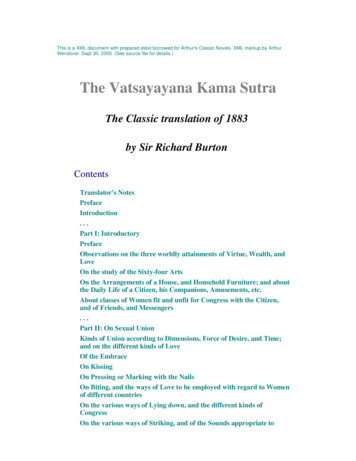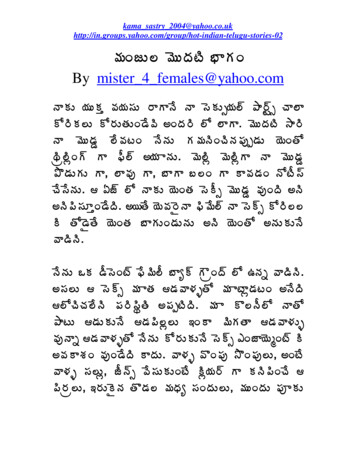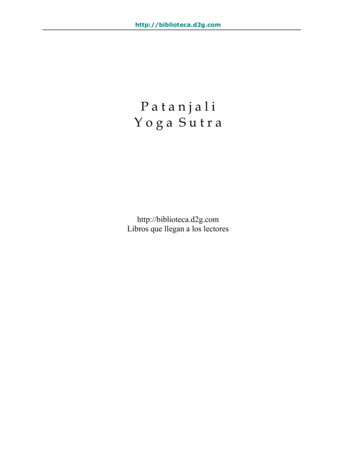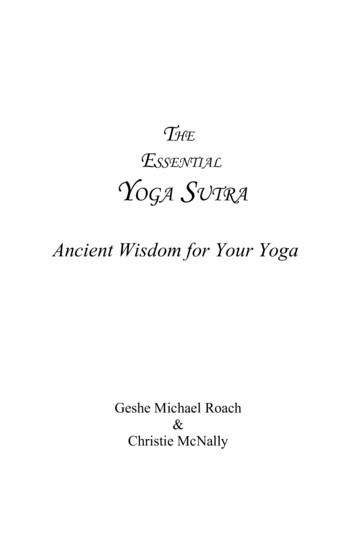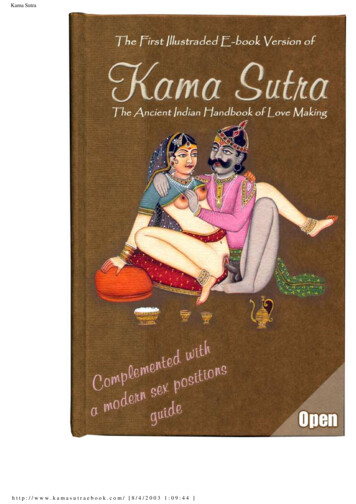
Transcription
Kama Sutrahttp://www.kamasutraebook.com/ [8/4/2003 1:09:44 ]
The Kama Sutra of Vatsayayana TRANSLATOR'SNOTES- Preface- Introduction PART I:INTRODUCTORY- Chapter I- Chapter II- Chapter III- Chapter IV- Chapter V PART II: ON SEXUALUNION- Chapter I- Chapter II- Chapter III- Chapter IV- Chapter V- Chapter VI- Chapter VII- Chapter VIII- Chapter IX- Chapter X PART III: ABOUT THEACQUISITION OF AWIFE- Chapter I- Chapter II- Chapter III- Chapter IV- Chapter V PART IV: ABOUT AWIFE- Chapter I- Chapter II PART V: ABOUT THEWIVES OF OTHERPEOPLE- Chapter I- Chapter II- Chapter III- Chapter IV- Chapter V- Chapter VI previous content next CONTENTTRANSLATOR'S NOTES Preface IntroductionMODERN KAMA SUTRA INTERPRETATION Over 40 sexual positions with images and detailed explanationsPART I: INTRODUCTORY Preface Observations on the three worldly attainments of Virtue, Wealth, and Love On the study of the Sixty-four Arts On the Arrangements of a House, and Household Furniture; and about theDaily Life of a Citizen, his Companions, Amusements, etc. About classes of Women fit and unfit for Congress with the Citizen, and ofFriends, and MessengersPART II: ON SEXUAL UNION Kinds of Union according to Dimensions, Force of Desire, and Time; and onthe different kinds of Love Of the Embrace On Kissing On Pressing or Marking with the Nails On Biting, and the ways of Love to be employed with regard to Women ofdifferent countries On the various ways of Lying down, and the different kinds of Congress On the various ways of Striking, and of the Sounds appropriate to them About females acting the part of Males On holding the Lingam in the Mouth How to begin and how to end the Congress. Different kinds of Congress, andLove QuarrelsPART III: ABOUT THE ACQUISITION OF A WIFE Observations on Betrothal and Marriage About creating Confidence in the Girl Courtship, and the manifestation of the feelings by outward signs and deeds On things to be done only by the Man, and the acquisition of the Girl thereby.Also what is to be done by a Girl to gain over a Man and subject him to her On the different Forms of Marriage previous content next PART VI: ABOUTCOURTESANS- Introductory Remarks Chapter I- Chapter II- Chapter III- Chapter IV- Chapter V- Chapter VI PART VII: ON THEMEANS OF ATTRACTINGOTHERS TO ONE'S SELF- Chapter I- Chapter II CONCLUDINGREMARKS MODERN l (1 of 2) [8/4/2003 1:09:46 ]
Kama Sutra TRANSLATOR'SNOTES- Preface- Introduction PART I:INTRODUCTORY- Chapter I- Chapter II- Chapter III- Chapter IV- Chapter V PART II: ON SEXUALUNION- Chapter I- Chapter II- Chapter III- Chapter IV- Chapter V- Chapter VI- Chapter VII- Chapter VIII- Chapter IX- Chapter X PART III: ABOUT THEACQUISITION OF AWIFE- Chapter I- Chapter II- Chapter III- Chapter IV- Chapter V PART IV: ABOUT AWIFE- Chapter I- Chapter II PART V: ABOUT THEWIVES OF OTHERPEOPLE- Chapter I- Chapter II- Chapter III- Chapter IV- Chapter V- Chapter VI PART VI: ABOUTCOURTESANS- Introductory Remarks Chapter I- Chapter II- Chapter III- Chapter IV- Chapter V- Chapter VI PART VII: ON THEMEANS OF ATTRACTINGOTHERS TO ONE'S SELF- Chapter I- Chapter II previous content next TRANSLATOR' S NOTESPrefaceIn the literature of all countries there will be found a certain number of workstreating especially of love. Everywhere the subject is dealt with differently, andfrom various points of view. In the present publication it is proposed to give acomplete translation of what is considered the standard work on love in Sanscritliterature, and which is called the Vatsyayana Kama Sutra', or Aphorisms onLove, by Vatsyayana. While the introduction will deal with the evidenceconcerning the date of the writing, and the commentaries written upon it, thechapters following the introduction will give a translation of the work itself. It is,however, advisable to furnish here a brief analysis of works of the same nature,prepared by authors who lived and wrote years after Vatsyayana had passedaway, but who still considered him as the great authority, and always quotedhim as the chief guide to Hindoo erotic literature.Besides the treatise of Vatsyayana the following works on the same subject areprocurable in India:The Ratirahasya, or secrets of loveThe Panchasakya, or the five arrowsThe Smara Pradipa, or the light of loveThe Ratimanjari, or the garland of loveThe Rasmanjari, or the sprout of loveThe Anunga Runga, or the stage of love; also called Kamaledhiplava, or a boatin the ocean of love.The author of the Secrets of Love' was a poet named Kukkoka. He composedhis work to please one Venudutta, who was perhaps a king. When writing hisown name at the end of each chapter he calls himself Siddha patiya pandita',i.e. an ingenious man among learned men. The work was translated into Hindiyears ago, and in this the author's name was written as Koka. And as the samename crept into all the translations into other languages in India, the bookbecame generally known, and the subject was popularly called Koka Shastra, ordoctrines of Koka, which is identical with the Kama Shastra, or doctrines oflove, and the words Koka Shastra and Kama Shastra are used indiscriminately.The work contains nearly eight hundred verses, and is divided into tenchapters, which are called Pachivedas. Some of the things treated of in thiswork are not to be found in the Vatsyayana, such as the four classes of women,the Padmini, Chitrini, Shankini and Hastini, as also the enumeration of the daysand hours on which the women of the different classes become subject to love,The author adds that he wrote these things from the opinions of Gonikaputraand Nandikeshwara, both of whom are mentioned by Vatsyayana, but theirworks are not now extant. It is difficult to give any approximate idea as to theyear in which the work was composed. It is only to be presumed that it waswritten after that of Vatsyayana, and previous to the other works on thissubject that are still extant. Vatsyayana gives the names of ten authors on thesubject, all of whose works he had consulted, but none of which are extant, anddoes not mention this one. This would tend to show that Kukkoka wrote afterVatsya, otherwise Vatsya would assuredly have mentioned him as an author inthis branch of literature along with the others. previous content next CONCLUDINGREMARKS MODERN KAMASUTRAhttp://www.kamasutraebook.com/p0 1.html (1 of 2) [8/4/2003 1:09:48 ]
Kama Sutra TRANSLATOR'SNOTES- Preface- Introduction PART I:INTRODUCTORY- Chapter I- Chapter II- Chapter III- Chapter IV- Chapter V PART II: ON SEXUALUNION- Chapter I- Chapter II- Chapter III- Chapter IV- Chapter V- Chapter VI- Chapter VII- Chapter VIII- Chapter IX- Chapter X PART III: ABOUT THEACQUISITION OF AWIFE- Chapter I- Chapter II- Chapter III- Chapter IV- Chapter V PART IV: ABOUT AWIFE- Chapter I- Chapter II PART V: ABOUT THEWIVES OF OTHERPEOPLE- Chapter I- Chapter II- Chapter III- Chapter IV- Chapter V- Chapter VI PART VI: ABOUTCOURTESANS- Introductory Remarks Chapter I- Chapter II- Chapter III- Chapter IV- Chapter V- Chapter VI previous content next TRANSLATOR' S NOTESIntroductionIt may be interesting to some persons to learn how it came about thatVatsyayana was first brought to light and translated into the English language.It happened thus. While translating with the pundits the Anunga Runga, or thestage of love', reference was frequently found to be made to one Vatsya. Thesage Vatsya was of this opinion, or of that opinion. The sage Vatsya said this,and so on. Naturally questions were asked who the sage was, and the punditsreplied that Vatsya was the author of the standard work on love in Sanscritliterature, that no Sanscrit library was complete without his work, and that itwas most difficult now to obtain in its entire state. The copy of the manuscriptobtained in Bombay was defective, and so the pundits wrote to Benares,Calcutta and Jeypoor for copies of the manuscript from Sanscrit libraries inthose places. Copies having been obtained, they were then compared with eachother, and with the aid of a Commentary called Jayamangla' a revised copy ofthe entire manuscript was prepared, and from this copy the English translationwas made. The following is the certificate of the chief pundit: The accompanying manuscript is corrected by me after comparing fourdifferent copies of the work. I had the assistance of a Commentary called"Jayamangla" for correcting the portion in the first five parts, but found greatdifficulty in correcting the remaining portion, because, with the exception of onecopy thereof which was tolerably correct, all the other copies I had were far tooincorrect. However, I took that portion as correct in which the majority of thecopies agreed with each other.'The Aphorisms on Love' by Vatsyayana contain about one thousand twohundred and fifty slokas or verses, and are divided into parts, parts intochapters, and chapters into paragraphs. The whole consists of seven parts,thirty-six chapters, and sixty-four paragraphs. Hardly anything is known aboutthe author. His real name is supposed to be Mallinaga or Mrillana, Vatsyayanabeing his family name. At the close of the work this is what he writes abouthimself: After reading and considering the works of Babhravya and other ancientauthors, and thinking over the meaning of the rules given by them, this treatisewas composed, according to the precepts of the Holy Writ, for the benefit of theworld, by Vatsyayana, while leading the life of a religious student at Benares,and wholly engaged in the contemplation of the Deity. This work is not to beused merely as an instrument for satisfying our desires. A person acquaintedwith the true principles of this science, who preserves his Dharma (virtue orreligious merit), his Artha (worldly wealth) and his Kama (pleasure or sensualgratification), and who has regard to the customs of the people, is sure toobtain the mastery over his senses. In short, an intelligent and knowing personattending to Dharma and Artha and also to Kama, without becoming the slaveof his passions, will obtain success in everything that he may do.' previous content next PART VII: ON THEMEANS OF ATTRACTINGOTHERS TO ONE'S SELF- Chapter I- Chapter II CONCLUDINGREMARKS MODERN KAMASUTRAhttp://www.kamasutraebook.com/p0 5.html (1 of 2) [8/4/2003 1:09:49 ]
Kama Sutra previous content next TRANSLATOR'SNOTES- Preface- IntroductionPART I:INTRODUCTORY- Chapter I- Chapter II- Chapter III- Chapter IV- Chapter VPART ICHAPTER IPreface PART II: ON SEXUALUNION- Chapter I- Chapter II- Chapter III- Chapter IV- Chapter V- Chapter VI- Chapter VII- Chapter VIII- Chapter IX- Chapter X PART III: ABOUT THEACQUISITION OF AWIFE- Chapter I- Chapter II- Chapter III- Chapter IV- Chapter V PART IV: ABOUT AWIFE- Chapter I- Chapter II PART V: ABOUT THEWIVES OF OTHERPEOPLE- Chapter I- Chapter II- Chapter III- Chapter IV- Chapter V- Chapter VI PART VI: ABOUTCOURTESANS- Introductory Remarks Chapter I- Chapter II- Chapter III- Chapter IV- Chapter V- Chapter VISalutation to Dharma, Artha and KamaIn the beginning, the Lord of Beings created men and women, and in the formof commandments in one hundred thousand chapters laid down rules forregulating their existence with regard to Dharma,(1) Artha,(2) and Kama.(3)Some of these commandments, namely those which treated of Dharma, wereseparately written by Swayambhu Manu; those that related to Artha werecompiled by Brihaspati; and those that referred to Kama were expounded byNandi, the follower of Mahadeva, in one thousand chapters.Now these Kama Sutra' (Aphorisms on Love), written by Nandi in onethousand chapters, were reproduced by Shvetaketu, the son of Uddvalaka, inan abbreviated form in five hundred chapters, and this work was again similarlyreproduced in an abridged form, in one hundred and fifty chapters, byBabhravya, an inheritant of the Punchala (South of Delhi) country. These onehundred and fifty chapters were then put together under seven heads or partsnamed severallySadharana (general topics)Samprayogika (embraces, etc.)Kanya Samprayuktaka (union of males and females)Bharyadhikarika (on one's own wife)Paradika (on the wives of other people)Vaisika (on courtesans)Aupamishadika (on the arts of seduction, tonic medicines, etc.)The sixth part of this last work was separately expounded by Dattaka at therequest of the public women of Pataliputra (Patna), and in the same wayCharayana explained the first part of it. The remaining parts, viz. the second,third, fourth, fifth, and seventh, were each separately expounded bySuvarnanabha (second part)Ghotakamukha (third part)Gonardiya (fourth part)Gonikaputra (fifth part)Kuchumara (seventh part), respectively.Thus the work being written in parts by different authors was almostunobtainable and, as the parts which were expounded by Dattaka and theothers treated only of the particular branches of the subject to which each partrelated, and moreover as the original work of Babhravya was difficult to bemastered on account of its length, Vatsyayana, therefore, composed his work ina small volume as an abstract of the whole of the works of the above namedauthors. previous content next PART VII: ON THEMEANS OF ATTRACTINGOTHERS TO ONE'S SELF- Chapter I- Chapter II CONCLUDINGREMARKS MODERN KAMASUTRAhttp://www.kamasutraebook.com/p1 1 1.html (1 of 2) [8/4/2003 1:09:51 ]
Kama Sutra TRANSLATOR'SNOTES- Preface- Introduction PART I:INTRODUCTORY- Chapter I- Chapter II- Chapter III- Chapter IV- Chapter V PART II: ON SEXUALUNION- Chapter I- Chapter II- Chapter III- Chapter IV- Chapter V- Chapter VI- Chapter VII- Chapter VIII- Chapter IX- Chapter X PART III: ABOUT THEACQUISITION OF AWIFE- Chapter I- Chapter II- Chapter III- Chapter IV- Chapter VPART IV: ABOUT AWIFE- Chapter I- Chapter II PART V: ABOUT THEWIVES OF OTHERPEOPLE- Chapter I- Chapter II- Chapter III- Chapter IV- Chapter V- Chapter VI PAR
Kama Sutra TRANSLATOR'S NOTES - Preface - Introduction PART I: INTRODUCTORY - Chapter I - Chapter II - Chapter III - Chapter IV - Chapter V PART II: ON SEXUAL UNION - Chapter I - Chapter II
